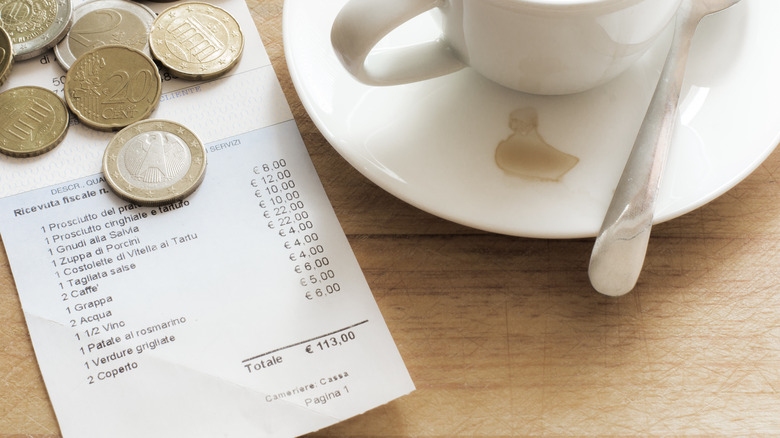Here's What It Really Means If You See A 'Servizio' Charge On Your Restaurant Bill In Italy
Dining in Italy should be a joy, and hopefully, most of the time, it is. But when it comes time to pay the bill, joy can quickly change to consternation when you can't figure out how it all adds up. First, there's the long list of items you've consumed, most likely written in Italian, even though you may have ordered using an English menu. Verdure grigliate? What's that? What's more, you will likely see charges for things like servizio or coperto, and you have no idea what these are for.
We can help solve those mysteries. First, you won't always encounter the servizio at restaurants in Italy. It's far more common in touristy areas, less so in venues frequented by locals (except for larger groups of eight persons or more). The servizio is used as a kind of "tourist tax," and it's usually around 10% of the total bill. Here's the thing though. For the servizio to be valid, the menu must indicate that this charge will be added to the cost of your meal. Check the menu's teeny tiny print, and if the servizio isn't mentioned, you are entitled to ask your server to remove it from your bill. However, steer clear of tourist trap restaurants and you may be able to avoid the servizio altogether.
Other things to know about your bill
Another mysterious charge on bills in Italian restaurants is the coperto. This is a perfectly legal charge of around $1—3.30 per person that's been around since the Middle Ages and covers the cost of using the restaurant amenities. In more expensive areas, the coperto tends to be higher, and considering that it's a per-person cost (not per table) it can really increase the price of meal for a family with a few children. Again, restaurants must indicate the amount of the coperto on their menu for it to be legally valid, so check the fine print, usually on the first or last page. Note that in Lazio (where Rome is located), the law prohibits restaurants from charging a coperto. Some get around this by calling it a pane instead, which is essentially the same thing.
After making sense of your bill, you may still be left with one final question: to tip or not? Tipping is not the norm throughout Italy, since most servers are paid a reasonable wage. That said, if you've experienced especially good service, you can leave a few euro coins as a token of appreciation as opposed to a tip that's a specific percentage of the bill. Buon appetito!

